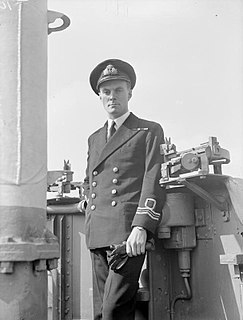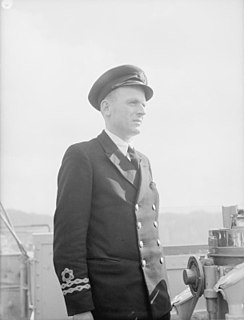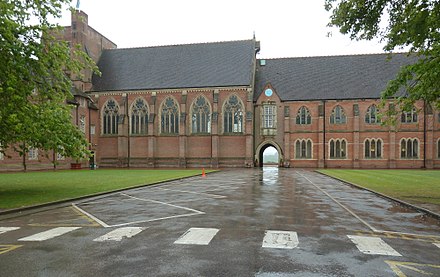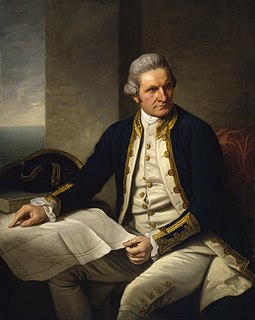
Ian Edward Fraser was an English diving pioneer and recipient of the Victoria Cross, the highest award for gallantry in the face of the enemy that can be awarded to British and Commonwealth forces. Fraser was born in Ealing in Middlesex and went to school in High Wycombe. After initially working on merchant ships and serving in the Royal Naval Reserve, he joined the Royal Navy at the start of the Second World War. After being awarded the Distinguished Service Cross for actions while serving on submarines, he was placed in command of a midget submarine during an attack in Singapore codenamed Operation Struggle. For his bravery in successfully navigating the mined waters, and successfully placing mines on a Japanese cruiser, Fraser was awarded the Victoria Cross.

Commander John Wallace Linton was a Royal Navy submariner and a Welsh recipient of the Victoria Cross, the highest award for gallantry in the face of the enemy that can be awarded to British and Commonwealth forces. His nickname was "Tubby" and he was a fine Rugby football forward, playing for the Royal Navy, United Services, and Hampshire County teams.

Admiral Sir Max Kennedy Horton, & Two Bars, SGM was a British submariner during the First World War and commander-in-chief of the Western Approaches in the later half of the Second World War, responsible for British participation in the Battle of the Atlantic. Max Horton was born in Anglesey to Robert Joseph Angel Horton and Esther/Hester Maude Goldsmid, of the famous Goldsmid/D'Avigdor Goldsmid Anglo Jewish family. Esther was born at the Hambro Synagogue in London and so Admiral Max Horton was fully Jewish on his mother's side and regarded as halachically Jewish.

HMS Storm was an S-class submarine of the Royal Navy, and part of the third group built of that class. She was built by Cammell Laird and launched on 18 May 1943. So far, she is the only RN ship to bear the name Storm.

Vice Admiral Sir Arthur Richard Hezlet, nicknamed Baldy Hezlet, was a decorated Royal Navy submariner. He became the Royal Navy's youngest captain at the time – aged 36 – and its youngest admiral, aged 45. In retirement he became a military historian.
The Royal New Zealand Naval Volunteer Reserve (RNZNVR) is the volunteer reserve force of the Royal New Zealand Navy (RNZN).
Ernest Martin Jehan DSC was an officer in the Royal Navy during the First World War. Jehan is best known for the sinking of a German U-boat by he and his crew aboard the smack Inverlyon. He began the war as a warrant officer and was decorated and commissioned after sinking SM UB-4 (2).

Edward Preston "Teddy" Young & Bar was a British graphic designer, submariner and publisher. In 1935 he joined the then new publishing firm of Penguin Books and was responsible for designing the cover scheme used by Penguin for many years as well as drawing the original penguin logo. During World War II he served in the Royal Naval Volunteer Reserve (RNVR) and became the first British RNVR officer to command a submarine. After the war he returned to the publishing world and eventually became managing director of the Rainbird Group. Having written his wartime biography, One Of Our Submarines, in 1952, he later wrote several other books.
Vice Admiral Sir John Anthony Rose Troup, was a Royal Navy officer. A submariner, he served as the last Commander-in-Chief Far East Fleet (1971).
Admiral Sir (Allen) Gordon Tait, KCB, DSC was a senior Royal Navy officer who went on to be Second Sea Lord and Chief of Naval Personnel.
Richard Barklie Lakin, DSO, DSC & Bar was a British industrialist, chairman of Vickers Armstrong and an officer in the Royal Navy during the Second World War.

Captain George Edward Hunt, was a highly decorated Royal Navy submarine commander during the Second World War. While commanding HMS Ultor, he became the British submarine commander with the greatest number of sinkings of enemy vessels to his name, though David Wanklyn achieved sinkings of greater tonnage. Of the 68 torpedoes Hunt fired, 47% hit their targets.
William Hedley Kett, DSC and Bar was a British submariner who commanded two ships during the Second World War.

Sir Robert Atkinson, was a British businessman and decorated Royal Navy officer. He served in the Royal Navy during World War II and was awarded the Distinguished Service Cross three times. Later, he was a businessman involved in shipbuilding and served as Chairman of British Shipbuilders from 1980 to 1984.

Herbert Arthur Stonehouse (1909-1984) was a British Royal Navy Reserve officer who was awarded the Distinguished Service Cross and bar for his service escorting convoys during the Second World War and who in 1943 sank the German submarine U-192.
Captain Leslie William Abel Bennington DSO & Bar, DSC & Two Bars was a British Royal Navy officer, who was highly decorated for his actions as a submarine commander during the Second World War.
Captain Howard Francis Bone was a British Royal Navy officer, who was highly decorated during his service as a submarine commander during the Second World War.

Captain Michael Lindsay Coulton "Tubby" Crawford DSC & Bar was an officer in the Royal Navy and submariner.















